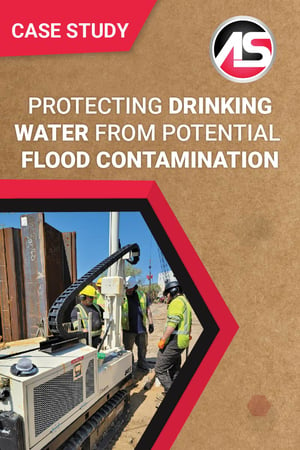
 Planners at Washington D.C.’s water utility, D.C. Water, decided to take proactive measures against potential flooding of their facility. Located right next to the Potomac, their facility could’ve been at risk in the event of an out-of-the-ordinary natural disaster. Determining that the main risk to the water supply in such a case would be permeation through sub-surface soil, they began installing a metal sheet pile wall deep into the substrate between the riverbank and the facility. However, in some spots they were not able to drive a sheet pile panel into the ground because of underground utility lines or rocky substrate. The planners called in LJS Waterproofing to create sub-surface grout walls in those spots to fill in the gaps.
Planners at Washington D.C.’s water utility, D.C. Water, decided to take proactive measures against potential flooding of their facility. Located right next to the Potomac, their facility could’ve been at risk in the event of an out-of-the-ordinary natural disaster. Determining that the main risk to the water supply in such a case would be permeation through sub-surface soil, they began installing a metal sheet pile wall deep into the substrate between the riverbank and the facility. However, in some spots they were not able to drive a sheet pile panel into the ground because of underground utility lines or rocky substrate. The planners called in LJS Waterproofing to create sub-surface grout walls in those spots to fill in the gaps.
Powerful Polymer
The LJS crew “constructed” these sections of the underground wall by injecting AP Fill 700. This is a single component, water-activated, hydrophobic, low viscosity, closed-cell polyurethane injection resin. This grout was used because it permeates the soil, fills small voids in the soil, and cuts off water flow.
Painless Procedure
LJS professionals used a Geoprobe to drive injection pipes into the ground (up to 33 feet in some locations). They then injected one gallon per foot using upward staging. The next injection point was 18 inches away from the first one. This process was repeated until a grout wall formed, filling the gap between the two adjacent underground sheet piles. For a large-scale job like this, LJS used the PolyShark single component grout pump.
Rapid Results
With solid, impermeable grout walls filling in the gaps, a sub-surface barrier between the riverbank and the drinking water facility was now in place. The planners at D.C. Water were very satisfied with this solution. LJS Waterproofing came through exactly in the way they had promised.



